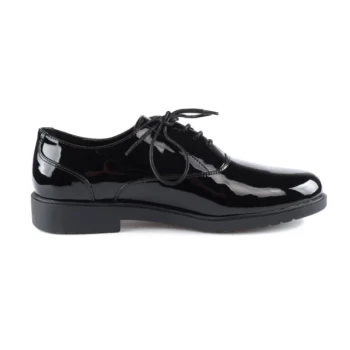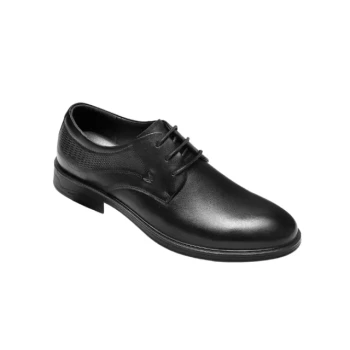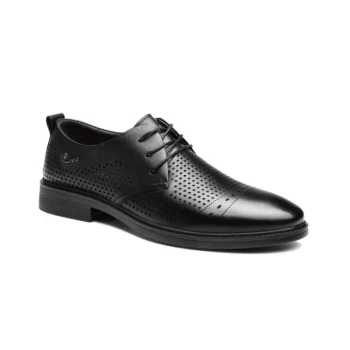At its core, an Oxford shoe is defined not by its color or material, but by its unique construction. Originating in the 19th century as a more comfortable alternative to the high boots of the era, the Oxford is characterized by its "closed lacing" system, where the pieces of leather holding the shoelace eyelets are stitched underneath the front part of the shoe, creating a sleek, clean, and formal silhouette.
The single, non-negotiable feature that makes an Oxford an Oxford is its closed lacing. This construction creates a snug fit and an elegant, unbroken profile, establishing it as the most formal and classic of all men's dress shoes.
The Evolution from Boot to Shoe
The Oxford's history marks a shift towards more practical and comfortable men's footwear. While its exact origin is debated, two primary narratives stand out.
From the Halls of Oxford University
One prominent theory traces the shoe to students at Oxford University around the 1820s. Rebelling against the restrictive, high-cut boots popular at the time, they favored a low-cut "Oxonian" boot with side slits, which eventually evolved to feature the centered laces we see today.
Scottish and Irish Influence
Another well-regarded origin story places the shoe in 19th-century Scotland and Ireland. Here, a simpler, more robust half-boot was developed, which later adopted the signature closed lacing system and became known as the Oxford.
What Truly Defines an Oxford?
Beyond its history, the shoe's identity lies in its specific anatomical features. These elements work together to produce its famously polished appearance.
The Closed Lacing System
This is the Oxford's most critical feature. The eyelet tabs (quarters) are stitched underneath the front part of the shoe (the vamp). This method hides the lacing mechanism for a tighter, cleaner look.
The result is a slim profile that hugs the foot's contour, creating an exceptionally formal appearance.
A Sleek and Slim Silhouette
Oxfords are built with a low heel and a refined shape. The closed lacing pulls the shoe together neatly, eliminating any visible gaps and contributing to its elegant and polished look.
Common Oxford Variations
While all Oxfords share the same lacing system, they come in several distinct styles.
- Cap-Toe: The most famous and classic type, featuring an extra piece of leather stitched over the toe box. It is the quintessential business shoe.
- Plain-Toe: A simple, unadorned design with no stitching on the toe, offering a very clean look.
- Whole-Cut: Made from a single piece of leather with only one seam at the back, representing the most formal and sleek variation.
- Wingtip: Features a pointed toe cap that extends along the sides of the shoe, often with decorative perforations (broguing).
Understanding the Trade-offs
The Oxford's defining characteristics create a specific set of advantages and limitations that are important to understand.
Formality vs. Versatility
The Oxford's sleek design places it at the peak of the dress shoe hierarchy. A black cap-toe or whole-cut Oxford is the undisputed standard for business suits, black-tie events, and weddings.
Brown or other colored Oxfords can be worn in less formal settings, but the shoe's fundamental structure remains inherently dressy.
The Challenge of Fit and Comfort
The closed lacing system offers less adjustability than other shoe constructions. This creates the signature snug fit, but it can be restrictive for individuals with wide feet or high arches.
Because there is less flexibility in the lacing, achieving the right size from the start is critical for long-term comfort, especially if you plan on standing or walking for extended periods.
Choosing the Right Oxford for Your Needs
Selecting the correct style depends entirely on your intended use and priorities.
- If your primary focus is maximum formality: Choose a black whole-cut or cap-toe Oxford with a high-quality leather sole.
- If your primary focus is business and professional wear: A black or dark brown cap-toe Oxford is the most reliable and appropriate choice.
- If your primary focus is a balance of style and comfort: Prioritize a perfect fit, especially if you have wider feet, and consider a brown Oxford for slightly more casual versatility.
The Oxford remains the cornerstone of a classic wardrobe due to its clean lines and timeless, formal authority.
Summary Table:
| Feature | Description |
|---|---|
| Key Origin | 19th century; evolved from university and regional styles for comfort. |
| Defining Trait | Closed lacing system for a sleek, formal silhouette. |
| Common Styles | Cap-Toe, Plain-Toe, Whole-Cut, Wingtip. |
| Best For | Business attire, formal events, and classic wardrobe staples. |
Ready to elevate your footwear collection with classic Oxfords?
As a large-scale manufacturer, 3515 produces a comprehensive range of footwear for distributors, brand owners, and bulk clients. Our production capabilities encompass all types of shoes and boots, including the timeless Oxford styles detailed in this article. We can help you source high-quality, comfortable, and stylish footwear that meets the demands of your market.
Contact us today to discuss your manufacturing needs and discover how we can bring value to your business.
Related Products
- Wholesale Comfortable Business Casual Shoes Custom Manufacturing
- Custom Manufactured Air Cushion Leather Business Shoes for Wholesale
- Wholesale Modern Business Shoes with Dial Closure System for Bulk Orders
- Wholesale Training Shoes with Dial Lacing System Custom OEM Manufacturing
- Wholesale Perforated Comfort Dress Shoes | Custom Derby Shoe Manufacturer
People Also Ask
- What should someone do if they are unsure about a company's dress code? Navigate with Confidence
- How should dress shoes be maintained to prolong their lifespan? A Guide to Lasting Quality
- Why is comfort important in dress shoes? Achieve All-Day Support for Professional Performance
- What are the long-term benefits of investing in quality dress shoes? Save Money & Boost Your Style
- What is business casual shoes? Master the Perfect Blend of Professional Style and Comfort



















